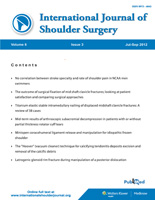 |
July-September 2012
Volume 6 | Issue 3
Page Nos. 71-100
Online since Wednesday, October 17, 2012
Accessed 14,001 times.
PDF access policy
Full text access is free in HTML pages; however the journal allows PDF access only to users from SOUTH AFRICA and paid subscribers.
EPub access policy
Full text in EPub is free except for the current issue. Access to the latest issue is reserved only for the paid subscribers.
|
| |
|
|
Show all abstracts Show selected abstracts Add to my list |
|
| ORIGINAL ARTICLES |
|
|
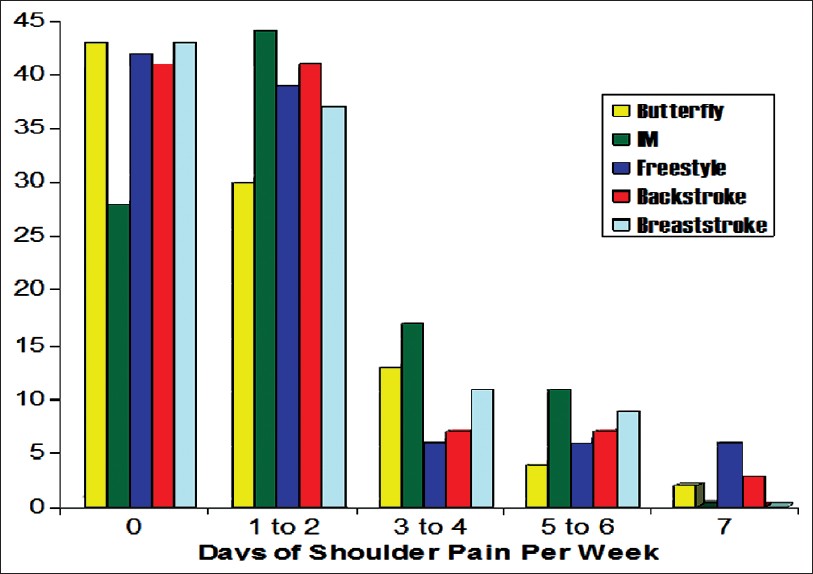  |
No correlation between stroke specialty and rate of shoulder pain in NCAA men swimmers |
p. 71 |
Lucas Wymore, Robert E Reeve, Christopher D Chaput
DOI:10.4103/0973-6042.102555 PMID:23204760Purpose: To established an association between shoulder pain and the stroke specialization among NCAA men swimmers.
Materials and Methods: All members of the top 25 NCAA men's swim teams were invited to complete the survey. Eleven teams with a total of 187 participants completed the study survey. The teams were mailed surveys that included multiple choice questions regarding their primary stroke and their incidence of shoulder pain. Additionally, the survey included questions about risk factors including distance trained, type of equipment, weight training, and stretching.
Results: The analysis showed that there was no significant difference in the rates of shoulder pain among the four strokes and individual medley specialists. The other risk factors did not show a significant correlation with shoulder pain.
Conclusions: This study found no significant correlation between stroke specialty and shoulder pain in male collegiate swimmers.
Level of Evidence: Level 3.
Clinical Relevance: Descriptive epidemiology study. |
| [ABSTRACT] [HTML Full text] [PDF] [Mobile Full text] [EPub] [PubMed] [Sword Plugin for Repository]Beta |
|
|
|
|
|
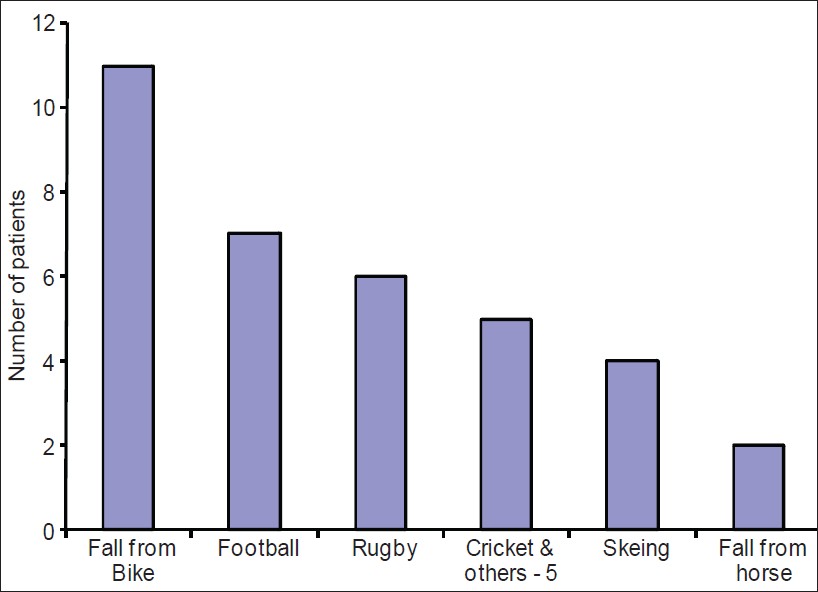  |
The outcome of surgical fixation of mid shaft clavicle fractures; looking at patient satisfaction and comparing surgical approaches |
p. 76 |
Zeiad A Alshameeri, Krishnaiah Katam, Mohammed Alsamaq, Paresh Sonsale
DOI:10.4103/0973-6042.102556 PMID:23204761Introduction: Clavicle fractures represent 2.5% of fractures in adults and almost 44% of shoulder injuries. The treatment is usually non-surgical with good results; however, significantly displaced fractures can be associated with high non-union rate and therefore many would advocate surgical fixation. This is traditionally carried out by direct approach over the clavicle but an infraclavicular approach has also been used for clavicular fixation. The aim of this study was to identify the main indications for surgical intervention at our unit and patient satisfaction following surgery. We also wanted to compare the direct and the infraclavicular surgical approaches in relation to the outcome of surgical intervention.
Materials and Methods : Retrospective study looking at all the clavicle fractures managed surgically over 5 years at our department. Information relating to surgical indication, surgical approach, complications, outcome, patient satisfaction, and oxford shoulder score were collected.
Results : A total of 35 patients were identified, the majority were males (n = 25) and most (n = 29) were working at the time of injury. The commonest indication for surgery was displacement with shortening (n = 16). The infraclavicular approach was used in the majority of patients (n = 21), the rest (n = 14) had direct incision. Evidence of radiological and union was achieved in all patients after an average of 13 (8-24) weeks. There were no major complications but minor complications were reported in 28% and 19% of cases with direct and infraclavicular approaches, respectively. Plates were removed from six symptomatic patients; infraclavicular (n = 2) and direct approach (n = 4). Four asymptomatic plates were removed on patients' requests. All patients returned to work (after an average 2.6 months), had good oxford shoulder score between 12-20, regardless of the surgical approach used. All patients except one would recommend it to a friend.
Conclusion : Our study showed excellent surgical outcome for displaced clavicle fractures supported by the high union rate, good oxford shoulder score, high return to work rate, and good patient's satisfaction. The number of minor complications and symptomatic metal work removal was less in the infraclavicular approach. |
| [ABSTRACT] [HTML Full text] [PDF] [Mobile Full text] [EPub] [Citations (2) ] [PubMed] [Sword Plugin for Repository]Beta |
|
|
|
|
|
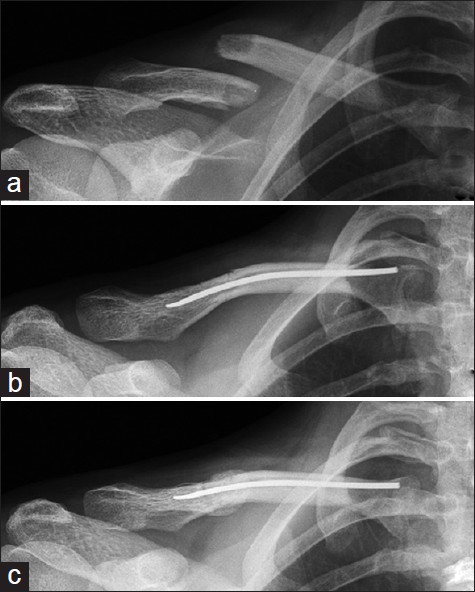  |
Titanium elastic stable intramedullary nailing of displaced midshaft clavicle fractures: A review of 38 cases |
p. 82 |
Anish P Kadakia, Rohit Rambani, Faisal Qamar, Steven McCoy, Lutz Koch, Balachandran Venkateswaran
DOI:10.4103/0973-6042.102557 PMID:23204762Introduction: Clavicle fractures accounting for 3 to 5% of all adult fractures are usually treated non-operatively. There is an increasing trend toward their surgical fixation. The aim of our study was to investigate the outcome following titanium elastic stable intramedullary nailing (ESIN) for midshaft non-comminuted clavicle fractures with >20 mm shortening/displacement.
Materials and Methods: A total of 38 patients, which met inclusion criteria, were reviewed retrospectively. There were 32 males and six females. The mean age was 27.6 years. The patients were assessed for clinical/radiological union and by Oxford Shoulder and QuickDASH scores. 71% patients required open reduction.
Results: 100% union was achieved at average of 11.3 weeks. The average follow-up was 12 months. The average Oxford Shoulder and QuickDASH scores were 45.6 and 6.7, respectively. 47% patients had nail removal. One patient had lateral nail protrusion while other required its medial trimming.
Conclusion: In our hands, ESIN is safe and minimally invasive with good patient satisfaction, cosmetic appearance, and overall outcome. |
| [ABSTRACT] [HTML Full text] [PDF] [Mobile Full text] [EPub] [Citations (3) ] [PubMed] [Sword Plugin for Repository]Beta |
|
|
|
|
|
|
Mid-term results of arthroscopic subacromial decompression in patients with or without partial thickness rotator cuff tears |
p. 86 |
Ahmed S Eid, Amitabh J Dwyer, Andrew F. W. Chambler
DOI:10.4103/0973-6042.102558 PMID:23204763Aim: To evaluate mid-term outcome in patients who underwent arthroscopic subacromial decompression (ASD) for shoulder impingement syndrome with intact and partially torn rotator cuffs.
Materials and Methods: A total of 80 consecutive patients (83 shoulders) who underwent ASD for impingement syndrome between 2003 and 2006 were analyzed. Mean age was 57.1 years. Patients' self-reported Oxford Shoulder Score (OSS) for pain was collected prospectively and was used as an instrument to measure surgical outcome.
Results: The mean initial and final OSS for patients with an intact rotator cuff was 26.1 and 40.3, respectively, at a mean follow up of 71.9 months (nearly 7 years). The mean initial and final OSS for patients with a partially torn articular sided tear was 22.6 and 41.9, respectively, at mean follow up of 70.7 months. Both groups showed significant sustained improvement (P < 0.0001). The mean improvement of OSS following ASD was statistically greater (P < 0.03) for partially torn rotator cuff group (19.3 points) as compared to those with normal rotator cuff (14.2 points).
Conclusion: Patients with dual pathology (partial rotator cuff tear and impingement) appreciated a significantly greater improvement following ASD compared to those with impingement alone. Both groups of patients had a similar final outcome at a mid-term follow up.
Level of Evidence: IV, retrospective study on consecutive series of patients. |
| [ABSTRACT] [HTML Full text] [PDF] [Mobile Full text] [EPub] [PubMed] [Sword Plugin for Repository]Beta |
|
|
|
|
|
|
| SURGICAL TECHNIQUES |
 |
|
|
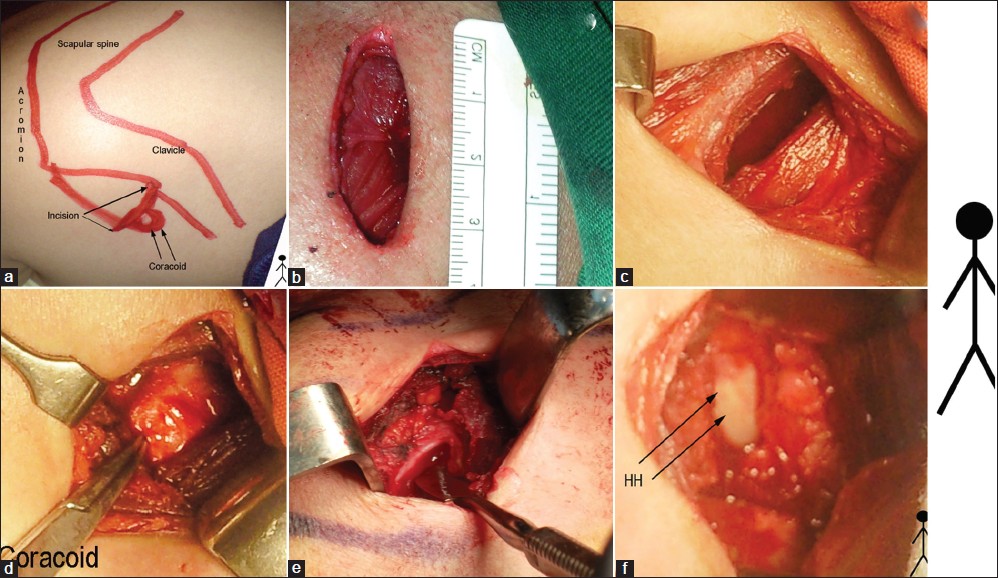  |
Miniopen coracohumeral ligament release and manipulation for idiopathic frozen shoulder |
p. 90 |
Abdelsalam Eid
DOI:10.4103/0973-6042.102561 PMID:23204764In the management of idiopathic frozen shoulder, manipulation under anaesthesia is known to have serious potential complications including fractures and intra-articular injuries. Arthroscopy is a safer treatment modality but requires special instruments, experience, and involves added cost. The aim of this work was to study the use of miniopen Coracohumeral ligament release and manipulation of the shoulder as a safe and simple method of treating idiopathic frozen shoulder that could be performed as a quick procedure under short duration anaesthesia obtaining a significant improvement of shoulder function while avoiding complications that are feared to occur with the use of manipulation under anaesthesia. Miniopen Coracohumeral ligament release is performed through a 3-cm incision. The Coracohumeral ligament is divided, and then the shoulder is manipulated without undue force. A case series including fifteen patients (19 shoulders) with idiopathic frozen shoulder operated by this technique is described. Miniopen Coracohumeral ligament release and manipulation is a quick procedure that may be performed under short duration anaesthesia obtaining a significant improvement of shoulder function meanwhile avoiding complications that are feared to occur with the use of manipulation under anaesthesia. |
| [ABSTRACT] [HTML Full text] [PDF] [Mobile Full text] [EPub] [PubMed] [Sword Plugin for Repository]Beta |
|
|
|
|
|
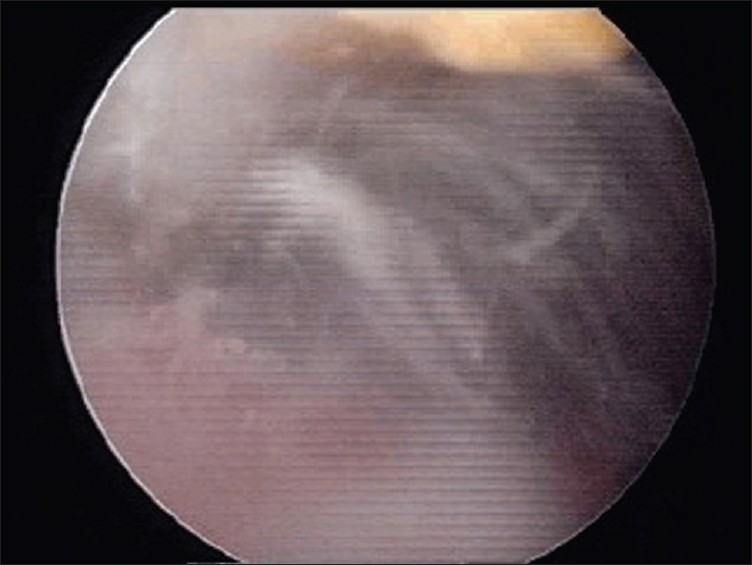  |
The "Hoover" (vacuum cleaner) technique for calcifying tendonitis deposits excision and removal of the calcific debris |
p. 97 |
Atoun Ehud, Rath Ehud, Van Tongel Alexander, Narvani Ali, Sforza Giusseppe, Levy Ofer
DOI:10.4103/0973-6042.102566 PMID:23204765A new technical tip for the improvement of the arthroscopic treatment of symptomatic calcifying tendinitis is described. Arthroscopic excision of calcifying tendonitis may result with multiple minute calcific debris in the subacromial bursa, causing severe post operative pain due to chemical irritation of the bursa. We suggest the use of a bladeless shaver barrel as a "Hoover" (vacuum cleaner) for arthroscopic clearance of these miniature calcific debris from the subacromial space after resection of the major deposits. The use of this technique resulted in good clinical outcome with improved post operative pain. |
| [ABSTRACT] [HTML Full text] [PDF] [Mobile Full text] [EPub] [PubMed] [Sword Plugin for Repository]Beta |
|
|
|
|
|
|
| LETTER TO THE EDITOR |
 |
|
|
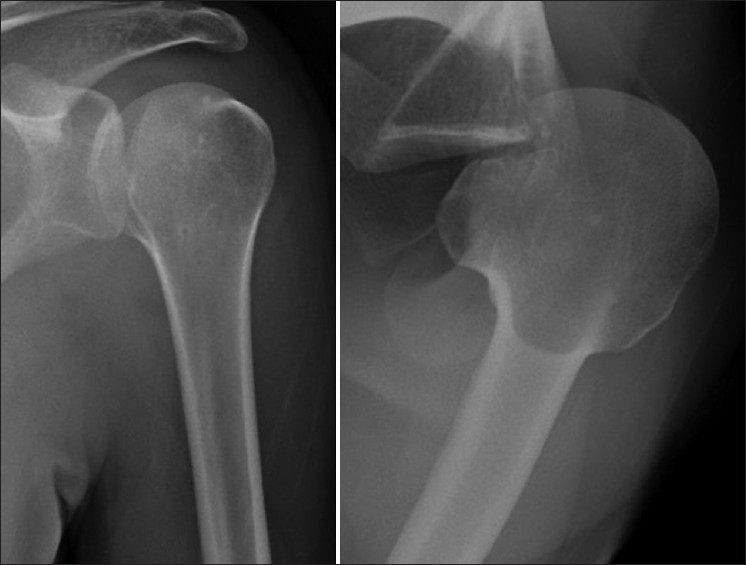  |
Latrogenic glenoid rim fracture during manipulation of a posterior dislocation |
p. 99 |
Tobias K. A. Baring, Philip M Ahrens
DOI:10.4103/0973-6042.102569 PMID:23204766 |
| [HTML Full text] [PDF] [Mobile Full text] [EPub] [Citations (1) ] [PubMed] [Sword Plugin for Repository]Beta |
|
|
|
|
|
